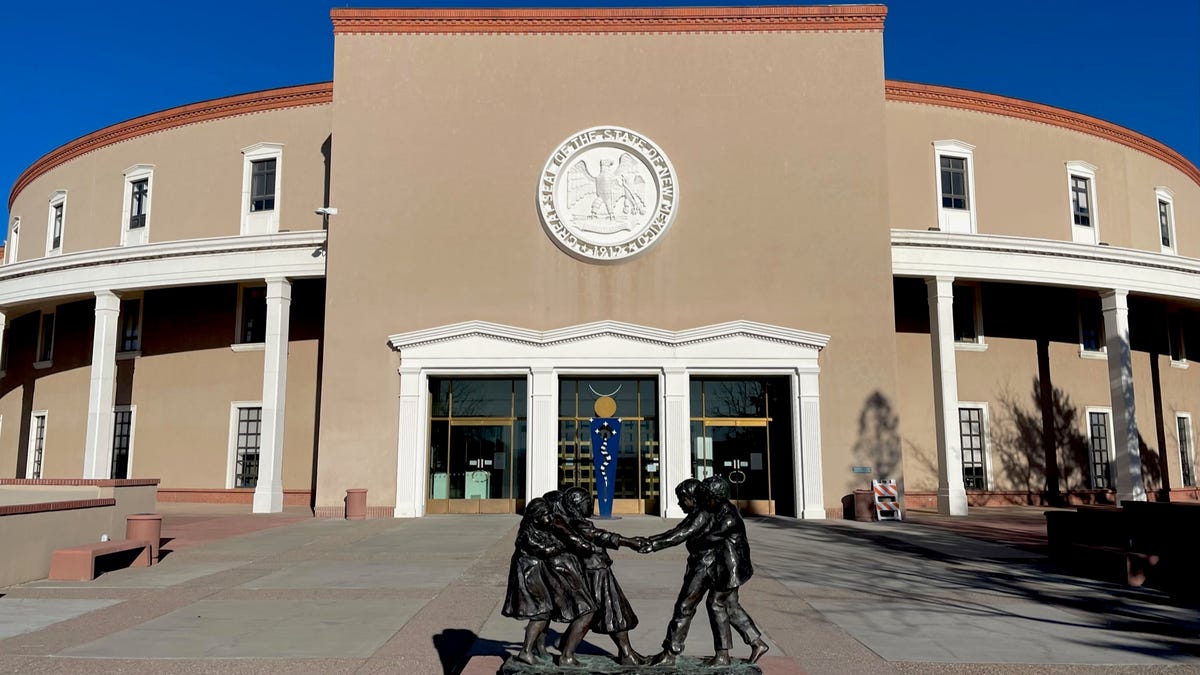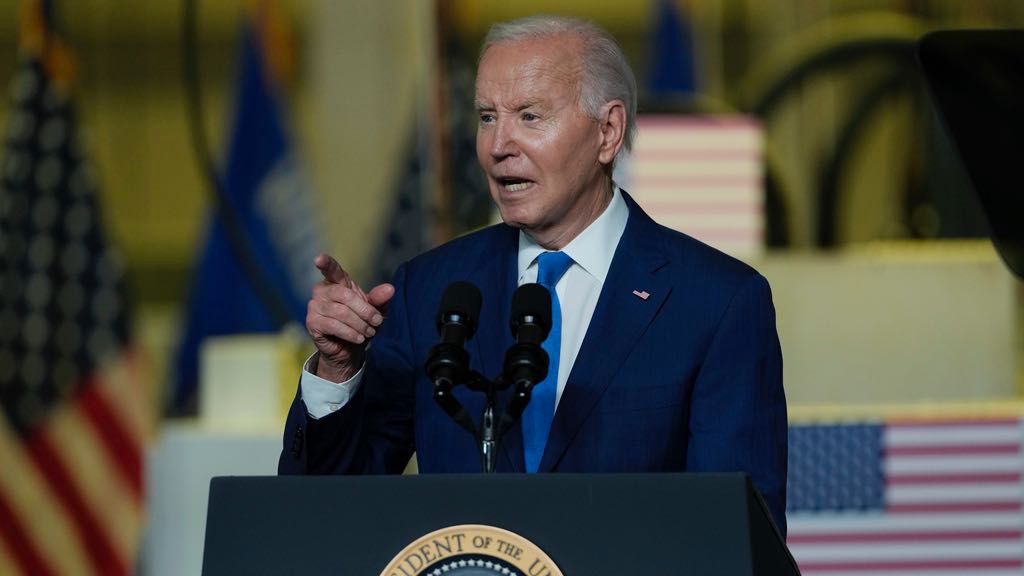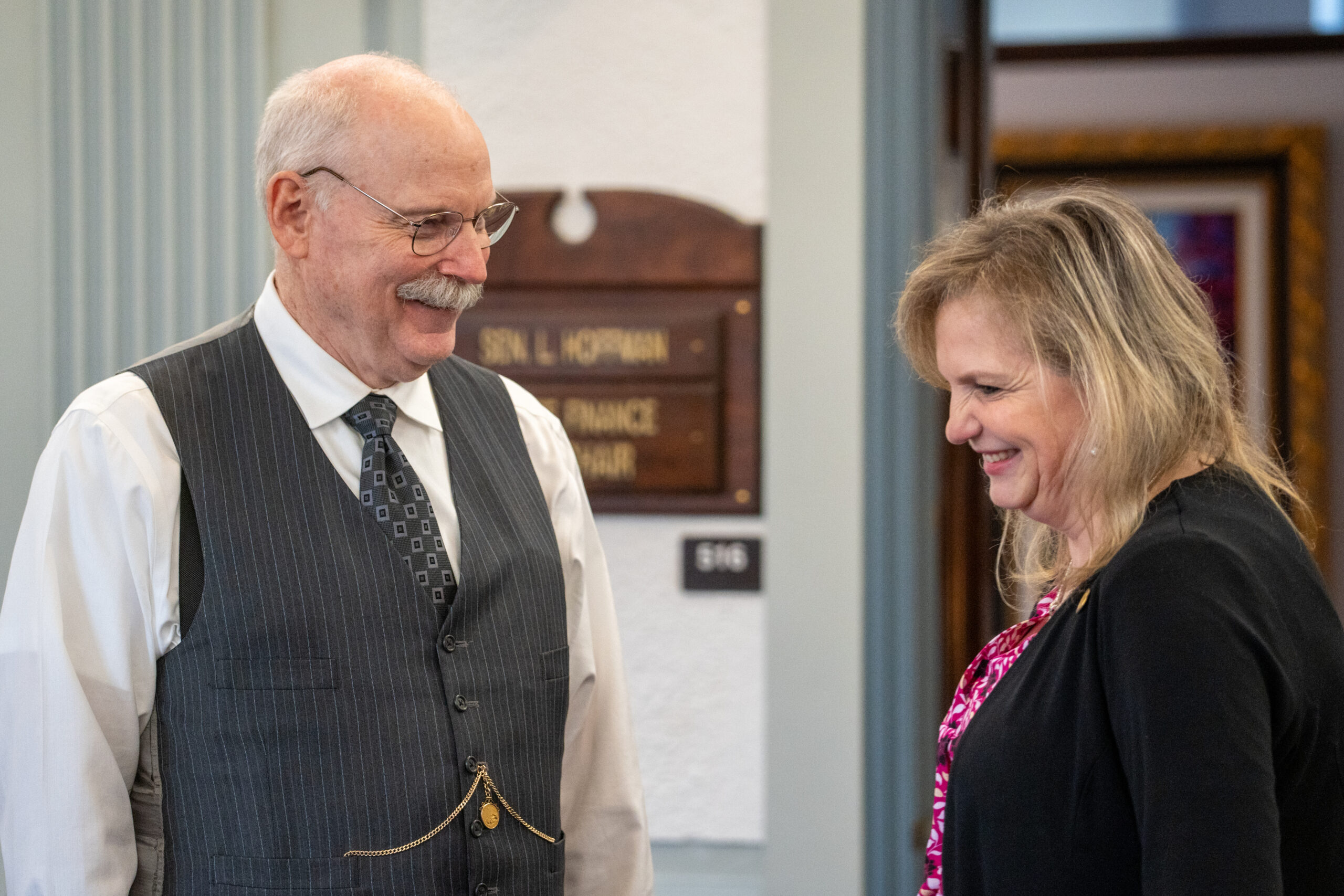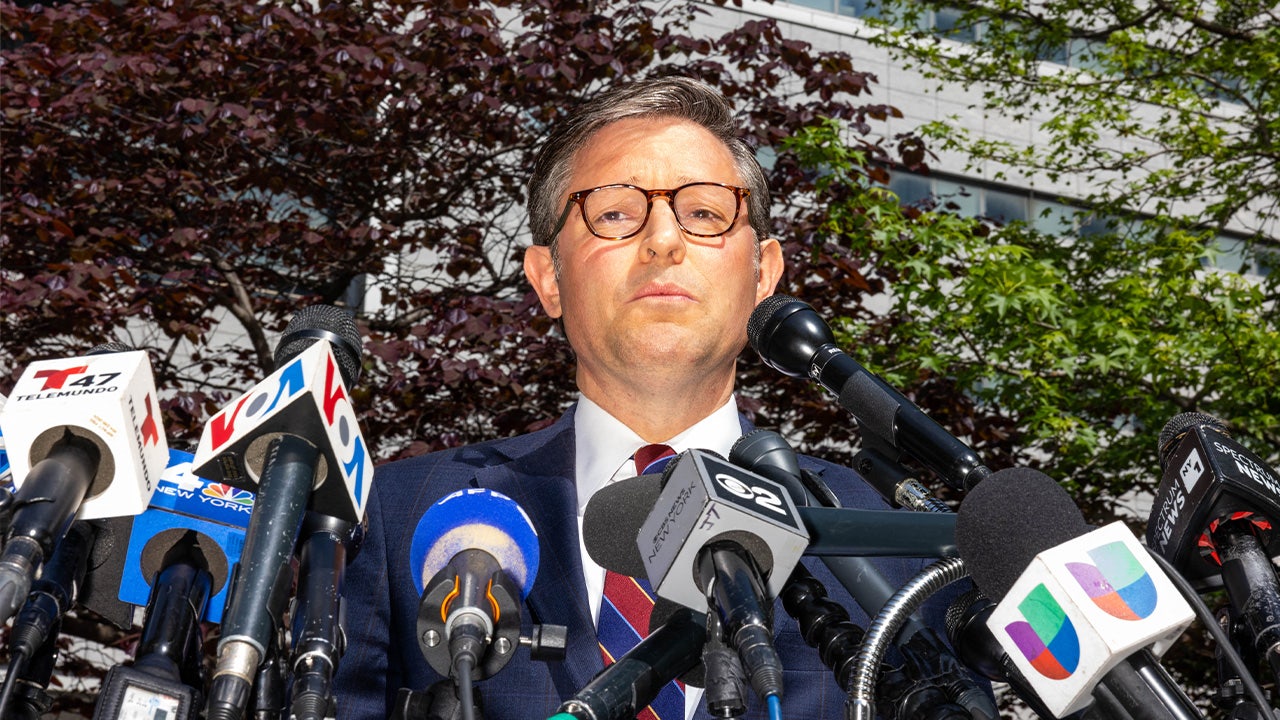New Mexico
Southeast New Mexico lawmakers claim victory, frustration after 2024 legislative session

Southeast New Mexico Republicans said they defended the oil and gas industry, gun rights and business owners from Democrat-led initiatives during the 2024 Legislative Session that concluded Feb. 15.
Several bills seeking to increase restrictions on firearms, regulations on industry and drive up costs for consumers were blocked or “watered down,” GOP leaders said, while others succeeded to the chagrin of the minority party.
This year’s session was focused on the budget, running for 30 days, compared to 60-day session convening on odd-numbered years.
More: New Mexico Democrats criticized for inaction on fentanyl bills
But that didn’t stop Democrats who control both the House and Senate and the Governor’s Office from pushing bills Republicans viewed as limiting constitutional rights or stymieing the economy via restrictions on New Mexico’s nation-leading fossil fuel industry.
Oil and gas bills mostly blocked after early-session momentum
Revenue from the fossil fuel industry accounted for about 54 percent of New Mexico’s revenue for the next fiscal year, contended Rep. Cathrynn Brown (R-54) of Carlsbad, displaying the industry’s import to the state.
House Bill 133 was intended to reform the Oil and Gas Act by adding requirements like setbacks between oil and gas facilities and residences or bodies of water. It also increased bonding requirements that operators pay to fund clean up of abandoned wells, and would have codified into law gas capture requirements enacted by the state’s Energy, Minerals and Natural Resources Department.
More: ‘Renewable’ geothermal energy boosted by bill passed by New Mexico House
Despite the setbacks being removed, and the bonding requirements tiered to reduce costs for smaller oil companies, the bill stalled on the House Floor without a vote.
Brown said this indicated more lawmakers, including Democrat leadership, were beginning to see the essential role oil and gas plays in New Mexico.
“The more you tax this industry, the less production you get and the less revenue for the state of New Mexico,” she said. “I think we started the session with the news that the oil and gas industry provided 54 percent of state revenue. That to me was a reality check to everyone about how important this industry is to the state.”
More: 2024 Legislative session wrap up: Here’s how energy and environment bills fared
Rep. Jim Townsend (R-54) of Artesia said in a likely first, major oil companies appeared to support the amended bill, while smaller, independent producers remained opposed.
“The smaller producers were not in favor of that,” Townsend said. “When you have a major lobbyist up there wanting something, you know it’s good for their shareholders. But I think, all in all, everybody did alright.”
House Bill 48, which would have raised royalty rates operators pay on the value of oil and gas also stalled − this time in the Senate Finance Committee despite passing the House.
More: Tax credits, rape kits & highways: Find out what bills your Eddy Co. Senators are sponsoring
“Most of the state land is already leased,” Brown said. “It was really a window dressing bill. It would not have produced much new revenue.”
Sen. Ron Griggs (R-34) touted his sponsored Senate Bill 64, which was added to the tax package passed by the legislature and awaiting approval from Gov. Michelle Lujan Grisham. He said this language allowed some exceptions for small oil and gas operators from paying severance taxes on low-producing or “stripper wells” while also devising a program to help those operators come into compliance with state regulations.
More: $300M needed for New Mexico land conservation; Supporters argue for funding in budget bill
“It’s probably the first oil and gas bill in the last 20 or 30 years that was favorable to the industry,” Griggs said. “But it’s also favorable to New Mexico because it allows them (oil companies) to continue producing oil and gas.”
Griggs, Brown and Townsend, like many members of their party, were heavily opposed to House Bill 41, known as the “Clean Transportation Fuels Standard” which passed the House and Senate and was awaiting Lujan Grisham’s signature as of Thursday.
HB 41 called on the state to begin a rulemaking targeting reductions in carbon pollution from cars and trucks, an action many viewed as favoring electric vehicles and driving up costs for energy companies.
More: Short term state revenue loss for Hobbs passes committee, bills for Carlsbad stalled
The bill would only serve to increase the price New Mexico drivers pay at the pump, Townsend said. Brown estimated the bill would increase gasoline prices by up to 50 cents per gallon.
“Hopefully the governor comes to her senses and realizes that’s a really partisan bill,” Townsend said. “That was a Democrat bill, and I think they’re going to pay for it.”
Democrats push gun reforms that infringe ‘constitutional rights,’ GOP says
Firearms were also a lead topic during the session in the wake of a Lujan Grisham executive order in September that banned open or concealed carry in Albuquerque and the surrounding area amid mounting gun violence.
More: Gov. Lujan Grisham wants New Mexico to spend big. Should oil and gas foot the bill?
The order was blocked by a federal judge days later, but Democrats signaled they remained set on adding restrictions on gun to address the state’s crime problems.
Two bills made it through the legislature this year: one that imposed a seven-day waiting period for gun sales after a background check, and another banning firearm possession at polling places.
Griggs said he expected a strong push for new gun laws from the other side of the aisle, but argued the Democratic Party’s approach would not impact criminals but law-abiding gun owners.
“The right to carry is constitutional,” he said. “All you do with this legislation is hurt the law-abiding guys. The bad guys will get them (guns). They’ll get whatever kinds of guns they can get a hold of.”
More: Republicans want to repeal New Mexico’s electric vehicle requirement
Townsend also challenged the recently-passed gun legislation as failing to address crime, contending lawmakers should have instead advanced multiple proposed bills this year to increase penalties for trafficking drugs like fentanyl allowing them to be accessed by children.
He questioned if New Mexico had ever had any gun-related incident at polling places.
“Why didn’t we do anything about fentanyl?” Townsend said. “There were a lot of things we could have done for crime in Albuquerque. It was unfortunate that we wasted our time on silly stuff.”
More: Too far or not far enough? Industry, environmentalist unite to opposed oil and gas reforms
Brown said the forefathers who drafted the U.S. Constitution never envisioned waiting periods when adding the Second Amendment, arguing such limits could affect the ability of women to defend themselves from domestic violence.
“We already have instant federal background checks. If it comes back to proceed, that person should be able to buy that firearm,” Brown said. “No person should have to wait seven days to defend themselves.”
GOP claims victory in blocking paid family medical leave
The minority party was successful in preventing Senate Bill 3, the Paid Family Medical Leave Act which would have created a state-run program to give workers up to 12 weeks off with no interruption in pay to address medical issues like doctor visits for family members.
More: Roads, school and national debt: Here’s what Eddy County representatives hope to make law
SB 3 would have created a fund for the program, requiring employers and employees to pay in.
The GOP argued this would unfairly burden businesses in New Mexico, and it was voted down on the House Floor after hours of debate.
Brown, who voted against SB 3, said it would take more money out New Mexicans’ pockets for a program she said not everyone would use.
“It would take money out of employees paychecks,” Brown said. “People don’t want to loose more of their paycheck. It’s paying into something most people wouldn’t use.”
Griggs said the bill needed to go through the Senate or House judiciary committees to fine tune its language to address multiple “holes” the bill had when introduced to lawmakers. This included language that allowed workers to use the program for people they “had an affinity for,” Griggs said, among several examples of language he said was too broad.
“I’m not sure why we would want to subject businesses to that,” Griggs said. “There’s a lot of open-ended things in that bill I hope they will address in the interim. It’s coming back.”
Adrian Hedden can be reached at 575-628-5516, achedden@currentargus.com or @AdrianHedden on the social media platform X.

New Mexico
4 lakes worth visiting in New Mexico this summer
New Mexico
New Mexico Loophole May Allow Record Methane Releases

In the first two months of the year, the pipeline company Targa Northern Delaware vented more climate-damaging natural gas from its operations in New Mexico than all other oil and gas producers in the state combined — 250% more, an amount equivalent to the carbon footprint of nearly 26,000 gasoline-powered cars driven for a year.
The state’s landmark 2021 Methane Rule banned routine venting and flaring of natural gas. But some 15 exceptions for pipeline operators allow such venting and flaring in certain circumstances, including when gas is so far out of pipeline specifications that it constitutes an “emergency,” which is what the company claimed 10 times in the first two months of the year, each time releasing millions of cubic feet of the potent greenhouse gas.
Those releases were enough to push the state’s January and February venting totals to their highest levels since the state began closely tracking venting and flaring in 2021 as part of the Methane Rule. That rule was put in place as part of New Mexico Gov. Michelle Lujan Grisham’s drive to rein in greenhouse gas emissions across the state, particularly in the oil and gas industry — the state’s biggest emitter. Natural gas is mostly methane, a highly potent greenhouse gas that is 80 times more capable of trapping heat in the atmosphere than carbon dioxide.
![]() The January and February releases represent “the worst-case scenario,” said Jon Goldstein, senior director of regulatory and legislative affairs at the Environmental Defense Fund.
The January and February releases represent “the worst-case scenario,” said Jon Goldstein, senior director of regulatory and legislative affairs at the Environmental Defense Fund.
“One of the things that the rules do is state that, whenever possible, you ought to be flaring and not venting,” he said. In emergencies, flaring natural gas — burning it at its production site — is “a necessary evil” and one that has a far lower climate-warming effect than venting unburned gas into the atmosphere.
“Why wasn’t this massive amount of gas routed to a flare?” Goldstein asked. Doing so would have reduced the equivalent carbon dioxide emissions by 90%.
The 10 venting incidents account for nearly all of the gas released by Targa Northern Delaware in those months, including the largest reported single release — more than 65,000,000 cubic feet — since detailed record keeping began in June 2021. The reason given in all 10 cases was, “Gas was vented to atmosphere to purge the pipeline of off-spec residue gas.”
“Historically, midstream operators like Targa weren’t even on our regulatory radar because they had no reporting requirements.”
~ Michael Coleman, communications director for Gov. Michelle Lujan Grisham
Pipelines have specifications for the composition of and contaminants in natural gas they accept from oil producers, and “Natural gas this out of spec can damage pipelines or pipeline components. This [is] why out of spec gas is one of the permissible emergency categories,” said Sidney Hill, public information officer with the Energy, Minerals and Natural Resources Department. In documents filed with the Oil Conservation Division, Targa Northern Delaware claims that the company repeatedly received impure gas from well operators, but it does not explain why the gas wasn’t then flared. “The OCD is further investigating the situation,” Hill said.
“With the data that it now can collect, EMNRD’s Oil Conservation Division has tools to ensure those claims are correct,” said Michael Coleman, communications director for Gov. Lujan Grisham. “If they prove not to be, we are confident EMNRD will take appropriate action.”
Oil Conservation Division records running from May of 2021, when the Methane Rule went into effect, to today show that Targa Northern Delaware has vented more natural gas in that time than any other company. It is a subsidiary of Targa Resources of Houston, a natural gas pipeline juggernaut that connects wells with major pipelines across New Mexico, Texas, Oklahoma, Louisiana and North Dakota. The company did not respond to requests for comment.
* * *
The biggest single natural gas vent in New Mexico’s recorded history happened in October, 2012, when Transwestern Pipeline Company depressurized an entire pipeline to replace a valve. More than 21 billion cubic feet of natural gas escaped into the atmosphere, equivalent to the emissions of 2.7 million gas-powered cars driven for a year. It is among the biggest single releases — if not the biggest — in U.S. history.
Though diminished over time, Transwestern Pipeline’s methane remains in the sky today, warming the planet and providing a real-time example of how the effects of methane venting — accidental or otherwise — linger for years.
Targa Northern Resources’ January and February emissions were orders of magnitude smaller, but they still warm the planet and will continue to do so for at least 20 years.
“Historically, midstream operators like Targa weren’t even on our regulatory radar because they had no reporting requirements,” Coleman said, because the Methane Rule had yet to be put in place. “It should also be noted that overall levels of venting, flaring and releases have not increased significantly in recent years, despite significant increases in total oil production.”
Not increasing significantly is not the same as decreasing, however. Alex DeGolia, director of state legislative and regulatory affairs with the Environmental Defense Fund, said that New Mexico is not on track to meet the climate goal set out by Gov. Lujan Grisham at the start of her term to reduce the state’s greenhouse gas emissions by 45% below the state’s 2005 level by 2030. The Methane Rule is a key part of that policy, one that the governor regularly trumpets.
“The rule itself is a good rule. It’s not a panacea. It’s not a ‘no venting ever’ rule.”
~ Tannis Fox, senior attorney, Western Environmental Law Center
“With all existing federal and state policies in place, as of last summer, the state was only on track to reduce emissions by 13%, according to our estimates,” DeGolia said. Since then, the state has passed clean car and truck laws and funded solar power grants. But, “New Mexico needs to actually be making sure that it is implementing its important regulations on methane emissions in particular,” he said, if it hopes to even reach 13%.
The International Energy Agency has said, “Oil and gas methane emissions represent one of the best near-term opportunities for climate action because the pathways for reducing them are well known and cost-effective.” But that’s only if oil and gas companies take those pathways.
“The longer we wait, the harder it will become, until the practicality of achieving the goal diminishes substantially,” DeGolia said. And whatever greenhouse gas reductions are not made by the most lucrative industry in the country, he said, “would need to come from elsewhere.”
That would be the people of New Mexico, the third-most impoverished state in the country according to 2021 data from the U.S. Census Bureau.
* * *
In the end, Targa Northern Delaware’s venting may be legal under the state’s Methane Rule. In fact, it’s “likely,” said Tannis Fox, a senior attorney at the Western Environmental Law Center.
“The rule itself is a good rule,” she said, but “It’s not a panacea. It’s not a ‘no venting ever’ rule.”
Fox was involved in its drafting along with others from the environmental community, the oil and gas industry, public representatives and those in government. And when they were done, she remembers thinking, “‘Well, gosh, there’s a lot of exceptions.’
“It was being touted, really by everybody … as a prohibition against venting and flaring,” she said. “It’s like, ‘Yeah, but…’”
The Oil Conservation Division is not the only state institution looking at Targa Northern Delaware and its emissions.
“Over a 10-day period, Targa Northern Delaware reports it emitted 91,000 pounds of VOCs [volatile organic chemicals], which is larger than any other single event during this time.”
~ Jorge Armando Estrada, public relations coordinator, New Mexico Environment Department
Industrial facilities that produce and release hazardous chemicals into the environment need a permit from the New Mexico Environment Department (NMED) that lays out exactly how much of those chemicals they can release before triggering a violation.
According to Jorge Armando Estrada, public relations coordinator with NMED, Targa Northern Delaware exceeded its permits 163 times in January and February alone. In total so far this year, Estrada said the company reported exceeding its emissions limits 277 times, representing 39% of all reports filed with the department, which monitors 441 companies.
In addition, he said, “Over a 10-day period, Targa Northern Delaware reports it emitted 91,000 pounds of VOCs [volatile organic chemicals], which is larger than any other single event during this time.”
VOCs are the building blocks of ozone pollution, which contributes to lung diseases and other health threats. In the last week of April, the American Lung Association released its annual State of the Air report card, which grades the air in cities and counties across the country. Targa Northern Delaware has its facilities in Lea and Eddy counties, which received a D and an F, respectively, due to ozone pollution from the oil and gas industry.

The Frac Cat Compressor Station in Lea County, New Mexico, is part of Targa Northern Delaware’s natural gas gathering system that vented record amounts of natural gas in the first two months of this year. Targa Resources bought Lucid in 2022.
On April 29, NMED announced a $24.5 million settlement with oil and gas producer Ameredev II, of Austin Texas. Most of that money will go to the New Mexico general fund. James Kenney, NMED department secretary, said, “I don’t know that the state has ever had a civil penalty in excess of $20-plus million with one oil and gas company.”
He said, “Almost everything that they told us on paper [about their facilities] was significantly underrepresented to what they actually installed in the field.” He continued, “It wasn’t a tiny home, but a very large mansion that they built in the very southeast corner of the state.” And over a year and a half ending in 2020, the company flared billions of cubic feet of natural gas and released 7.6 million pounds of volatile organic compounds beyond their operating permit.
The flaring and releases ended four years ago, and in the time since, NMED wrangled with the company to reach the settlement. That kind of long-term legal fight between state agencies and oil and gas companies is not uncommon, and doesn’t always end in an immediate settlement.
Goldstein, the senior director at the Environmental Defense Fund, noted that NMED and the Oil Conservation Division received funding bumps in the last few legislative sessions, “But they’re still, I think, underwater.”
Whether it’s Gov. Lujan Grisham or the New Mexico Legislature, “I think they all need to be reflective of the role that these agencies play, in terms of protecting the health of New Mexicans,” he said.
It can take years to push new penalties or penalty rates through New Mexico’s Legislature and agency governing boards. However, the Ameredev settlement includes what may be a new method of funding similar enforcement actions. “The Legislature has authorized us to issue permits, and we can charge for those permits,” Kenney said. “When you don’t comply with your permit, we can charge you our staff’s time to come into compliance with that permit.”
And with Ameredev, the New Mexico Environment Department assessed a new $413,000 fee that goes directly to NMED. Going forward, “We’re effectively charging staff time to return people to compliance,” Kenney said.
Copyright 2024 Capital & Main.
Photos by Jerry Redfern.
New Mexico
El Paso residents rally to protect a Rio Grande Wetland • Source New Mexico

EL PASO—Dozens of people crammed into a conference room on the eastern edge of El Paso on a recent Thursday evening. Some brought signs, some wore T-shirts, others diligently wrote their feedback on notecards. But the message was resounding: Don’t build a highway near our wetland.
Conservation advocates in El Paso say the Texas Department of Transportation (TxDOT) should steer clear of the Rio Bosque Wetlands Park as it considers potential highway expansion in southeast El Paso County. TxDOT is in the early planning phase to improve mobility in the Mission Valley. A corridor study identified three possible routes to extend a highway through the area. All three routes run alongside the Rio Bosque, a 372-acre park managed by the University of Texas at El Paso (UTEP) and the local water utility, El Paso Water.
The idea has elicited an uproar among El Paso residents who treasure the restored wetland ecosystem at Rio Bosque. Wetlands lined the Rio Grande in El Paso before a series of engineering projects straightened the river and encased the riverbed in concrete. But beginning in the 1990s, UTEP led a group of local conservationists who revived a dried-out river bend to make the Rio Bosque park. The wetland ecosystem now attracts hundreds of bird species and local universities rely on the park for fieldwork.
Rio Bosque is one of a handful of wetlands restoration projects along the Rio Grande in Southern New Mexico and West Texas, which environmental scientists compare to a “string of pearls” that improves wildlife connectivity across the region.
Conservation advocate Jon Rezendes said a highway next to Rio Bosque would be a “death trap” for birds and flying insects. “It will functionally kill Rio Bosque,” he said.
Transportation is the second-biggest source of greenhouse gas emissions in Texas after industry, accounting for about a third of emissions. Carbon emissions from vehicles in Texas are steadily increasing. Texas is increasing funding for highways, with the most recent budget appropriating $32.7 billion for state highway projects.
But both in Texas and nationwide, the role of highways is being re-examined. Residents have organized against highway expansions in cities like Houston and Austin, and federal transportation agencies are addressing the legacy of highways that pass through communities of color. In El Paso, TxDOT has studied the possibility of extending the Border Highway, which runs through south-central and southeast El Paso along the border wall, further east since the 1990s. But the latest iteration of the study has sparked spirited opposition from conservation advocates.
TxDOT says the area needs more road capacity. But El Pasoans are calling for alternatives that don’t impact Rio Bosque and other historical and cultural sites in the area.
Jennifer Wright, a spokesperson for TxDOT’s El Paso office, said that if a project comes out of the corridor study, it will take years to secure funding and go through the permitting process.
For now, she said, the concept maps are nothing more than ideas from engineers about what options would be “reasonable and feasible” to address traffic issues in the area. She said there is no “imminent threat” to Rio Bosque.
El Paso lost its wetlands — until Rio Bosque
When the city of El Paso took ownership of Rio Bosque in 1973, it was a dry patch of land overtaken by invasive saltcedar trees. But local conservationists had a vision: to restore the wetlands that once lined the banks of the Rio Grande.
In the late 19th and early 20th centuries, seasonal floods on the Rio Grande caused widespread damage in El Paso and Ciudad Juárez, its Mexican sister city. The Treaty of Guadalupe Hidalgo at the end of the Mexican-American War established the river as the international border in 1848. But the river changed course with each flood season, flummoxing officials trying to map the official boundary.
To prevent floods, improve irrigation and solidify the international boundary, the meandering Rio Grande through El Paso-Juárez was straightened and encased in concrete between the 1880s and the 1930s. “There are few river systems in the world that have experienced such massive transformation so rapidly,” wrote a group of environmental scientists in a 2023 paper.
University of Texas at Austin environmental historian C.J. Alvarez, who studies construction on the border, calls the Rio Grande through El Paso and Ciudad Juárez “more damaged, more manipulated, and more engineered” than any other section of the 1,900-mile long river. 
The free-flowing Rio Grande was transformed into a channel dedicated to farm irrigation.
The bends and oxbows of the river were eliminated. The wetlands along the river’s banks dried out.
The Rio Bosque land occupied one of those old, dried-out river bends.
The idea to create a wetland at Rio Bosque got off the ground in the late 1990s. UTEP’s Center for Environmental Resource Management signed on to manage the site. John Sproul has served as the park’s manager ever since, now with the help of assistant park manager Sergio Samaniego, a UTEP graduate.
Their biggest challenge is securing water to fill the wetlands, especially in dry years like 2023, when El Paso only received 4.34 inches of rain, about half of the average annual precipitation. El Paso Water provides treated wastewater from its nearby treatment plant. The park also gets irrigation water from the Rio Grande and relies on wells.
But the hard work is paying off and native vegetation like Rio Grande cottonwoods and Goodding’s willows are now well-established. Birds have flocked to the park, which the border fence separates from the Rio Grande. Threatened species like the western yellow-billed cuckoo, which migrates from Central and South America and had not been sighted for years in El Paso, was first spotted at Rio Bosque in 2007. It’s become a popular spot for birders who keep a running list online of their sightings.
“Any effort, no matter how small, to remind people what it would look like to rewild the place—to look back in time before the big engineering projects—is a good thing,” Alvarez said.
Growing pains in the Mission Valley
While the Rio Bosque wetlands was taking shape in the late 1990s, transportation planners were also eying the area. TxDOT completed a feasibility study in 1997 that laid out conceptual designs for a highway stretching 20 miles between the Zaragoza bridge—two miles north of Rio Bosque — and the border crossing at Fabens, Texas. That first study references Rio Bosque and the “proposed wetlands preserve.”
The study sat dormant for years. TxDOT revisited the study in 2013 and 2014 to create an updated Border Highway East Corridor Study. The conceptual route for the highway ran northeast of Rio Bosque. During public comments in 2013, numerous people urged TxDOT to move the highway further away from Rio Bosque.
Meanwhile, the communities around Rio Bosque were changing. Farmland was gradually being developed for housing, bringing more cars to the area’s aging roads. Commercial truck traffic from Juárez into El Paso at the Ysleta-Zaragoza International Bridge steadily increased. By 2020, there were over 587,000 truck crossings into El Paso at the bridge, up 52 percent from 2010.
“With the increase in population and commercial traffic and activity at the port of entry, the congestion is getting worse and worse,” said Iliana Holguin, county commissioner for Precinct 3, which includes Socorro and the Lower Valley. “We have tremendous mobility needs in that area but we also have to protect the resources that are there.”
El Paso’s Mission Valley is named for the area’s three original Spanish missions: Ysleta, Socorro and San Elizario. Ysleta is now within the El Paso city limits, just north of Rio Bosque, and Socorro and San Elizario are municipalities south of the park. Socorro, the area’s first mission, was founded in 1682.
The valley is also El Paso’s most important agricultural area, fed by the Rio Grande. It is also home to Ysleta del Sur Pueblo, one of three federally recognized tribes in Texas. Also known as Tigua Pueblo, its members were displaced from what is now New Mexico in the 1600s and resettled on their current lands.

TxDOT’s concepts also have the highway passing by the Tigua’s tribal lands. The Tribal Council did not respond to a request for comment on TxDOT’s corridor study.
“[Rio Bosque] is a place of prayer, a place to have peace,” said Andrea Everett, a member of the Ysleta del Sur Pueblo and environmental scientist. “It is the last place that actually looks like when our ancestors were displaced here in 1680.”
Everett, who studied the impacts of environmental change on the Ysleta del Sur Pueblo in her graduate studies at UTEP, said that Rio Bosque is an important place for her and her family to connect with their ancestors and the riparian ecosystem that once surrounded their tribal lands.
“We’re already an urban tribe but we’re trying to hold on to what we have,” she said.
‘A rewilding success story’
Jon Rezendes fell in love with El Paso and its mountains while serving in the military at Fort Bliss. After leaving the military, Rezendes and his wife and children stayed in the desert city. Rezendes started taking his kids to Rio Bosque, where they would watch for birds and explore miles of dirt trails.
“Rio Bosque is a true rewilding success story,” Rezendes said, referring to the process of increasing biodiversity and restoring the natural processes of an ecosystem, including the reintroduction of native species. “For me the idea of returning the land to its natural state in any way we can is beautiful.”
Rezendes learned about the corridor study, and as a volunteer with local conservation groups, he spread the word about TxDOT public meetings held the first week of May. He attended a meeting on May 2 wearing a Protect Rio Bosque t-shirt and said he will keep fighting until TxDOT abandons the idea.
During the public meeting, concept maps were rolled out on tables and participants voiced their opposition on sticky notes affixed to the maps: “We need public transportation,” one read. “Wouldn’t the completion of a border bike system be awesome?” read another.
Wright, TxDOT’s spokesperson, said public transportation is not currently included in the concepts.
UTEP declined to make Rio Bosque staff available for interviews. While TxDOT’s conceptual routes do not directly cut onto the park property, two routes lay just northeast of the park and the third to the southwest of the park, between its boundaries and the border fence. The Rio Bosque newsletter for April alerted supporters to the risks if a highway is built in this buffer zone, stating that the buffer provides “an avenue for wildlife movement between the park and other areas.”

El Paso Water, which helps manage the park, came out against the three concepts from TxDOT’s study, saying a highway could impact the utility’s nearby wastewater treatment plant and Rio Bosque. In a statement, the utility said all three options would “pose serious environmental threats” to Rio Bosque.
Rio Bosque “is also one of the few and unique public open spaces in the Lower Valley where families can enjoy trails, go bird watching, and learn what El Paso looked like prior to modern development,” said Gilbert Trejo, the utility’s vice president of operations.
TxDOT project manager Gus Sanchez said he and his colleagues heard the feedback in 2014 and moved the potential routes to go around Rio Bosque and not cross the property. Opponents say even if the highway does not cross Rio Bosque property, wildlife will be in danger and noise and light pollution would fundamentally change the park.
“We’re constrained because we have Rio Bosque on the south side and neighborhoods on the north side,” Sanchez explained. “It’s not like we can move it a half-mile north.”
Wright said there are models for creating wildlife crossings that TxDOT has used in other locations. She referenced crossings for ocelots in South Texas as one example. Once a specific design is completed, the project would be subject to further review, including one to ensure it complies with the National Environmental Protection Act.
“We’re not interested in destroying habitat,” Wright said. “[Rio Bosque] is clearly a treasured element in our city. But we need to take a look.”
If the vigorous debate at public meetings this month is any indication, the fight for Rio Bosque is only getting started. For many in this border city, the 372-acre park is more than a place to go birding or hiking: it’s a symbol of the river ecosystem that was lost and recovered and, with enough will, might be preserved for future generations.
-

 Politics1 week ago
Politics1 week agoHouse Dems seeking re-election seemingly reverse course, call on Biden to 'bring order to the southern border'
-

 World1 week ago
World1 week agoSpain and Argentina trade jibes in row before visit by President Milei
-

 Politics1 week ago
Politics1 week agoFetterman says anti-Israel campus protests ‘working against peace' in Middle East, not putting hostages first
-

 World1 week ago
World1 week agoGerman socialist candidate attacked before EU elections
-

 News1 week ago
News1 week agoUS man diagnosed with brain damage after allegedly being pushed into lake
-

 World1 week ago
World1 week agoGaza ceasefire talks at crucial stage as Hamas delegation leaves Cairo
-

 Politics1 week ago
Politics1 week agoRepublicans believe college campus chaos works in their favor
-

 Politics1 week ago
Politics1 week agoConservative beer brand plans 'Frat Boy Summer' event celebrating college students who defended American flag





















